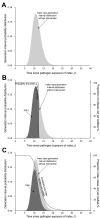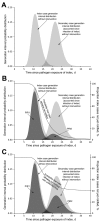Quantifying reporting timeliness to improve outbreak control
- PMID: 25625374
- PMCID: PMC4313625
- DOI: 10.3201/eid2102.130504
Quantifying reporting timeliness to improve outbreak control
Abstract
The extent to which reporting delays should be reduced to gain substantial improvement in outbreak control is unclear. We developed a model to quantitatively assess reporting timeliness. Using reporting speed data for 6 infectious diseases in the notification system in the Netherlands, we calculated the proportion of infections produced by index and secondary cases until the index case is reported. We assumed interventions that immediately stop transmission. Reporting delays render useful only those interventions that stop transmission from index and secondary cases. We found that current reporting delays are adequate for hepatitis A and B control. However, reporting delays should be reduced by a few days to improve measles and mumps control, by at least 10 days to improve shigellosis control, and by at least 5 weeks to substantially improve pertussis control. Our method provides quantitative insight into the required reporting delay reductions needed to achieve outbreak control and other transmission prevention goals.
Figures







References
MeSH terms
LinkOut - more resources
Full Text Sources
Other Literature Sources
Medical

